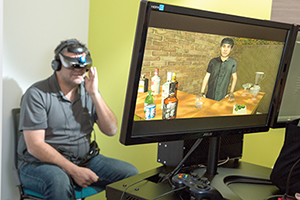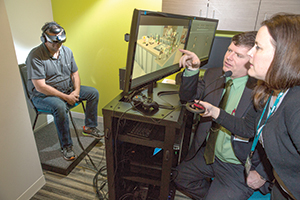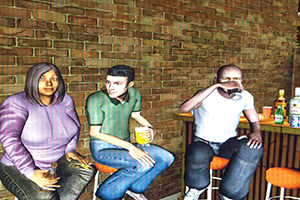AMITA Health Alexian Brothers center is an early adopter
By COLLEEN SCHRAPPEN
A man with an alcohol addiction walks through the airport. He decides to stop at the bar, just to get something to eat. But the scent of whiskey — his drink of choice — is in the air. The bartender turns and says, "What will you have?"

A patient at the Foglia Family Foundation Residential Treatment Center in suburban Chicago enters a virtual bar where he is greeted by an avatar bartender. In his 3-D goggles, the patient sees the image that is projected on the computer screen in the foreground. A therapist uses the computer to guide the "cue exposure" experience.
Rich Chapman/© CHA
Before he can answer, another voice interrupts. It is the man's therapist. She asks him what he is experiencing, where his level of craving falls on a scale of 1 to 10.
She is not actually at the airport. In fact, neither is he. This is virtual reality.
The bartender is an avatar, and the scent of alcohol has been generated by a machine. The patient and his therapist are in a treatment room at the Foglia Family Foundation Residential Treatment Center in Elk Grove Village, Ill., a suburb of Chicago, and the patient is undergoing virtual reality therapy.
Sarah Briley, a counselor who oversees addiction services at the treatment center, uses virtual reality technology with many of her patients. It's part of a multipronged approach that the center, which opened in April, is using to treat patients with chemical dependency, post-traumatic stress disorder, mental health problems or some combination thereof.
The 48-bed Foglia behavioral health center is a repurposed building on the campus of its sister institution, the AMITA Health Alexian Brothers Medical Center. It is part of AMITA Health Alexian Brothers Behavioral Health Hospital about 9 miles away in Hoffman Estates, Ill.
Briley said the center is the only residential treatment program she knows of that uses virtual reality. However, it is used at some outpatient treatment programs.
Cue exposures
"There's not much happening (with virtual reality therapy) in the U.S.," Briley said. Traditional addiction treatment taught people to avoid people and places that triggered cravings. "But those strategies only get you so far. Virtual reality can address the internal discomfort" a patient feels when confronted with a stressful or tempting situation.

A patient undergoes cue exposure therapy at the Foglia Family Foundation Residential Treatment Center under the guidance of counselor Sarah Briley, who oversees addiction services there, and Patrick McGrath, assistant vice president of residential services for the AMITA Health Behavioral Medicine Institute. Rich Chapman/© CHA
Patrick McGrath, a doctor of clinical psychology who is assistant vice president of residential services for the AMITA Health Behavioral Medicine Institute and an expert on anxiety disorders, calls those "cue exposures."
For a patient with an addiction, the cue exposure could be a liquor store or a loft party. In the treatment of chemical dependency, "we want to teach people how to deal with cravings, that they can sit with that craving," said McGrath. "You may have cravings for the rest of your life."
For someone with anxiety, public speaking, riding on an airplane or climbing a ladder might trigger feelings of panic. For veterans with post-traumatic stress disorder, loud noises or large crowds can be a trigger. Therapists at Foglia specialize in the treatment of multi-symptomatic patients with multiple diagnoses. Virtual reality therapy has utility in those multifaceted treatment plans.
Modulated response
Virtual reality therapy is used to habituate the patient to a trigger stimulus and dial back the body's intense response. A patient puts on 3-D goggles and a headset to step into an environment populated by avatars. The therapist controls the stimulus from a nearby computer console. At times, patients aren't receptive to the virtual reality technology, or they find that they experience some motion sickness when they wear the goggles. But, most patients tolerate it well and "they are fully engaged in it," McGrath said.
The systems, which cost about $30,000, have a variety of "suites" to replicate environments such as an elevator, a packed conference room or an Iraqi battlefield. Smells, such as gunpowder or burning garbage, can be produced. Vibrations from a rumble pad can mimic the waves of energy unleashed in an explosion.
The more exposure a person has to a triggering situation, the less impact it will have over time, said McGrath, who has been using virtual reality in his practice for about eight years.
"Think of PTSD as the fear of a memory," McGrath said. "So, if you've been in a battle scenario and that haunts you, and that image plays over and over again in nightmares and flashbacks — if you try to make that go away, you make the memory more intense.
"We expose vets to things they've experienced to let them know they can handle it … you start with the lowest-level stuff and build up till you re-create the person's memory. You take it at the pace of the person. There's no cookie-cutter response to this."
One tool among many
Virtual reality is one component of Foglia's exposure and response prevention approach to treatment, which aims to provide a safe environment in which patients can repeatedly experience a trigger in order to develop healthy coping skills that negate avoidance or distraction-seeking responses.
Individualized therapy plans for patients with dual or multiple diagnoses also include cognitive behavior therapy and mindfulness therapy. There are 12-step groups for those in addiction recovery.

Exposure to computer screen avatars imbibing alcoholic beverages, along with the wafting scent of alcohol, are used to teach a patient recovering from alcohol addiction how to deal with situations that trigger real-life cravings.
Rich Chapman/© CHA
Most patients reside at Foglia for three to six weeks, then continue to follow individualized step-down treatment plans.
McGrath collaborates with Virtually Better of Decatur, Ga., which sells the goggles, software and other system equipment and has been studying the results of virtual reality treatment for the past two decades. McGrath and his team provide feedback on the technology and outcome data for Virtually Better, which collaborates with the National Institutes of Health and the Department of Defense. The company continuously updates its systems based on the feedback it receives.
"Over the next decade, I think virtual reality is going to explode as a treatment modality," McGrath said of virtual reality therapy.
Before Briley, the addiction specialist, began using virtual reality with her patients, she did her own literature review and was encouraged by what she found. "People are cautiously optimistic," Briley said.
"Patients are usually pretty intrigued" by the virtual reality therapy experience offered at Foglia, she said. "Most have failed at lower levels of care and are looking to do something different."
Copyright © 2017 by the Catholic Health Association
of the United States
For reprint permission, contact Betty Crosby or call (314) 253-3490.